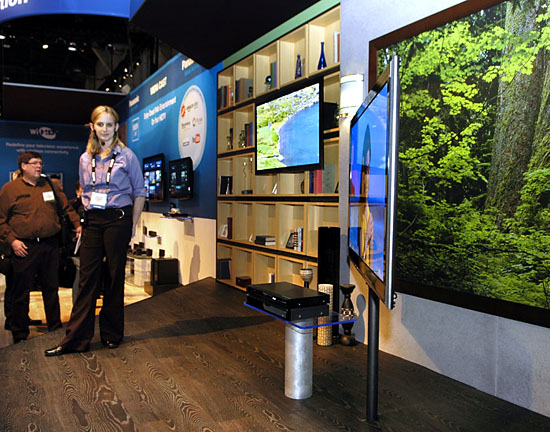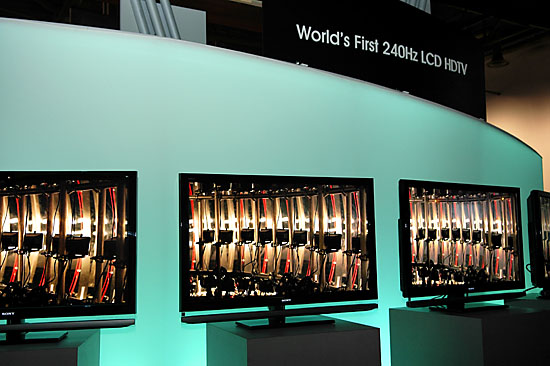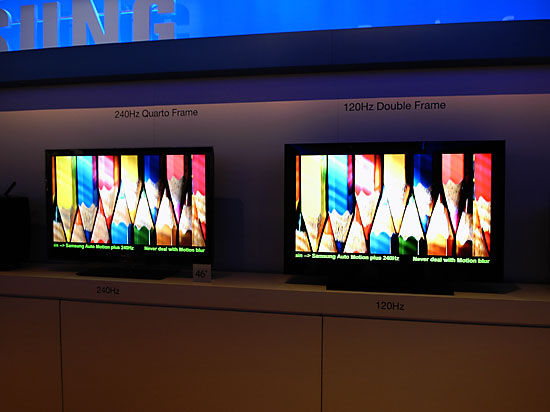CES 2009 - TV Trends, WirelessHD, 240Hz and Netbook Pricing
by Anand Lal Shimpi & Manveer Wasson on January 12, 2009 12:00 AM EST- Posted in
- Trade Shows
More TV Trends: Thin, Local Dimming and 240Hz

Panasonic demonstrated a 1” thick plasma display as well as a prototype 1/3” plasma at this year’s CES.

Thin is in. WirelessHD should eventually help reduce the thickness of TVs as well.
We also saw a brightness and power consumption demo similar to what was shown off last year. In short, brightness per watt is improving with newer panels over older ones. If you have a plasma or LCD that’s only 3 or 4 years old, you’ll most likely see a huge improvement either in brightness or power consumption (or both) by moving to a newer panel.
The LCD vs. Plasma debate basically boils down to this: LCDs have brighter whites and plasmas have deeper blacks (there’s also the glare issue but let’s ignore that for now). Given the lower cost of LCD panels at smaller, more mainstream sizes, TV makers are often looking for ways to improve black levels without sacrificing white levels.
If you could control the backlight of individual areas of the panel, you could turn it off completely in dark areas and leave it on in white areas. The concept and technology has been around for a while, but what we needed was rear-lit LED backlighting to make it affordable.
Instead of the panel being lit from the sides, with a rear-lit (or full matrix) backlight it’s illuminated from behind using many LEDs. With a true backlight composed of many LEDs it’s easy to dynamically turn on/off groups of them depending on the scene. The result is better black levels without sacrificing the bright whites that make LCDs so desirable. We saw similar technologies demonstrated last year in the Panasonic and Pioneer plasmas at CES 2008.
Another potential benefit of full matrix LED backlighting is what Toshiba and some other manufacturers are calling the 240Hz effect. Last year we saw the beginnings of a move to 120Hz LCDs, which you may remember isn’t LCD panels with 120Hz refresh rates. There are only 60 frames of data displayed, the data in between two frames is simply interpolated on the fly effectively giving you 120 frames per second (but from only 60 frames worth of data).

The 240Hz panels don’t interpolate a second time, instead some use a technique called backlight scanning. You still perform the same 120Hz effect but you turn portions of the backlight on and off very quickly to make for 240 different frames per second. Sets that support 240Hz in this manner obviously can also support local dimming, but it’s unclear if they can do both at the same time.

Samsung uses interpolation on its 240Hz TVs
Some manufacturers are interpolating a second time, so you get one original frame and 3 interpolated frames, at a rate of 240Hz without doing any backlight trickery. On paper this sounds like a better implementation however the displays that use additional interpolation also lack local dimming. Both Samsung and Sony generate 240 frames using interpolation and both companies use edge-lit LED backlights. Interestingly enough, Samsung used a rear-lit LED backlight in last year’s model with local dimming support and moved away from it this year.

OLED TVs were at CES, but still not ready for mainstream consumption yet
Internet Enabled TVs
We saw streaming internet content in CE products in early forms at last year’s CES. This year, companies have forged partnerships with the likes of Netflix, YouTube, and Yahoo in order to provide content directly to TVs and Blu-Ray players. Unfortunately, each CE company has forged alliances with different content providers. So while Sony can provide you with YouTube and Amazon Video streaming, it will not provide streaming HD Netflix movies like LG and Samsung can.
Although the idea of not needing to hook up a PC to your TV to view your favorite YouTube videos is nice, locking content providers to specific CE companies certainly hinders its usefulness. Streaming content is probably not a deal breaker for most consumers’ CE purchases.










30 Comments
View All Comments
araczynski - Monday, January 12, 2009 - link
I guess its a good thing then that I don't watch enough TV/Movies to care about these new tv developments. My two 2 year old LCD's will just have to 'do' until they die.the only netbook i've ever liked is that acer aspire one (i believe thats its name), $350 at walmart. only turn off is the lcd size in comparison to the top bezel size, seems like a waste of space. if you make the bezel of a certain size, fill it.
JimmiG - Monday, January 12, 2009 - link
Totally agree with Mooly about the Netbook pricing. A netbook is by definition affordable, and an Atom-powered Netbook performs as you would expect from a $300 ultra-portable.However, there is currently a gap in the market that computer manufacturers are trying to fill. There are the classic "ultra-portable" laptops that have been around forever and cost upwards of $2000 or more, and then there are the new $300 Netbooks. There isn't anything in between really. So they're taking their Atom designs and putting them into more stylish chassis to create e.g. a $900 Netbook. Those kinds of computers should really feature low-power Core2 Duo processors instead, but I guess that would drive the price up. A dual-core mobile Atom with a few IPC tweaks, running at 2+ GHz might work, or a scaled down Core2 or i7 CPU.
The Atom has gained much brand recognition. It seems everyone wants an Atom. It's also a return to Netbust and the "MHz myth" - 1.6 GHz doesn't sound that bad, but what many don't realize is that it's an in-order CPU a la 1993, with an IPC of less than half that of a Core2 CPU.
Zoomer - Saturday, January 24, 2009 - link
How many netbooks weight 1.2lbs?James5mith - Monday, January 12, 2009 - link
Ahh, IPC, it always comes back to IPC. :)elerick - Monday, January 12, 2009 - link
I have been really wanting to know some of the features of the plasma's. I have heard the worlds largest plasma plant capable of producing over 1 million units per month is almost complete, in China.Do the new plasma panels offer THX or ISF calibration controls?
Visual - Monday, January 12, 2009 - link
Local dimming is a terrible idea - as it also dims the bright pixels in the same general area. It will only be a good feature once it can be done with pixel precision, but that would just mean a LED TV instead of LCD.quiksilvr - Monday, January 12, 2009 - link
In my opinion, the smallest size a notebook should be is nothing under 11". 11" notebooks are smaller than a sheet of paper, and be it on your lap, on a plane, in a classroom, or in a coffee shop, you will ALWAYS be able to fit a footprint of a sheet of paper in front of you comfortably. As such I feel that 10" and 9" notebooks should not exist.Another reason why I feel that 11" should be the smallest size is because you can also fit an optical drive in these notebooks, something I feel is still a necessity. Wouldn't be nice to have your netbook as a portable DVD player too without having to rip the DVD onto a flash drive and plug it into your notebook?
IMO, the netbook hasn't reached to the point of reaching its full potential. Hopefully by the summer time the following specs can be available as the base model for a $500 price point:
11" 1280x720 screen (LED, 1.3 MP camera)
Highest CPU clock available for Atom
nVidia 9400M GT
2 GB RAM
32GB SSD
DVD RW/CD RW
802.11 a/b/g/n with Bluetooth 2.1
3G and GPS (let us activate it with a cell phone provider of OUR choosing, just have it there by default)
Windows XP (maybe Windows 7)
6 cell battery
Until then what's available now simply is just too expensive.
strikeback03 - Monday, January 12, 2009 - link
Unless they would include both GSM and CDMA hardware, you wouldn't be able to activate it on each of the available choices.Penti - Monday, January 12, 2009 - link
Forget about the Atom and it maybe possible with like AMD Neo @ 1.5 - 1.6GHz. (K8 single-core)And for twice the price!
The problem with high resolution 8-11" panels/screens are that none are made. OEM/ODMs can't do more then simply ordering the parts and put it together really. They aren't cheep either. 1280x800 or 1280x768 is do able though. Samsung has a 10.6" with 1280x768.
tayhimself - Monday, January 12, 2009 - link
Would you like a pie in the sky with that?